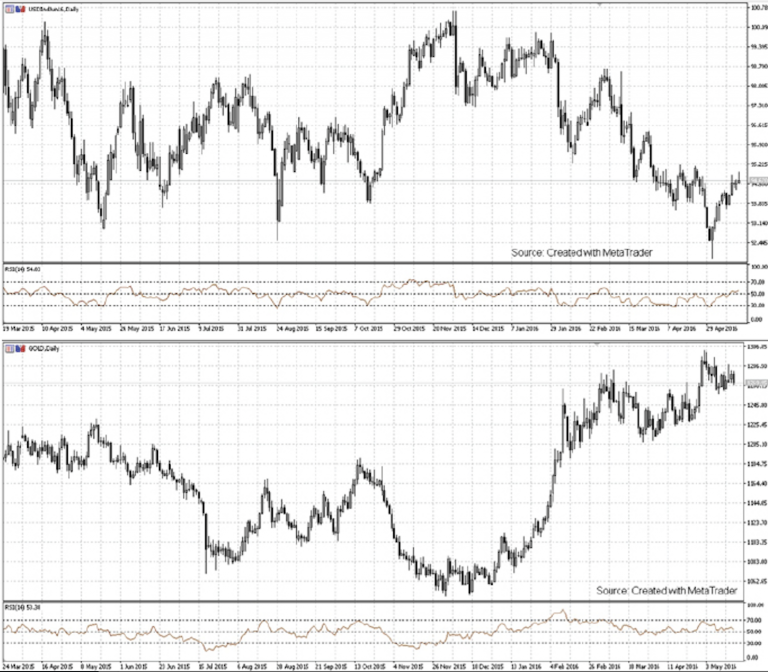
The evolution of commodity prices is generally opposite to the American dollar (USD). Let’s see the reasons behind this relationship and what the main movers for the USD are.
UNDERSTANDING THE CORRELATION BETWEEN USD AND COMMODITIES
WHY DOES THE USD AND COMMODITIES PRICES TEND TO EVOLVE IN OPPOSITE DIRECTIONS?
There are several reasons why the USD has an impact on commodity prices, but the main reason remains the fact that commodities are denominated in dollars.
The United States is considered as one of the strongest and most stable economies in the world. Consequently, the USD is the main reserve currency in the world, and before most currencies in the world were pegged to the USD. Commodities are no exception because they are also denominated in USD.
Generally speaking, the Dollar Index is used to track the evolution of the USD. It was in the 70’s that this index was developed to measure relative changes in the USD against a basket of currencies: EUR, JPY, GBP, CAD, SEK and CHF. If the Dollar Index increases, then the USD strengthens against those currencies, and vice versa.
When the dollar strengthens, it means that commodities become more expensive for people who hold currencies other than the dollar. This will have a negative impact on demand. Indeed, if the dollar strengthens against the currency of a commodities buyer, then he will have to spend more of his own currency in order to buy the same amount of commodities as before. They therefore become more expensive, demand decreases due to lower purchasing power, and prices fall. Conversely, when the dollar weakens, the price of commodities tends to increase, because any weakening of the USD stimulates commodities buyers with other currencies, which will increase their purchasing power.
But this negative correlation between the USD and commodities is not as simple or as binary as it seems. After the 2008 financial crisis, the inverse relationship between the USD and commodities was particularly strong, while before that time, it was more difficult to establish this kind of relationship.
According to a Bloomberg survey conducted over the period 1990-2015, nearly 60% of the time the negative correlation between the USD and commodities existed. In nearly 40% of the time, there was a positive correlation, with around 23% of this 40% describing a situation of an increase in both USD and commodities prices, and around 16% of the 40% describing a situation of a drop in the USD and commodities.
- See more at: https://www.forexboat.com/understanding-the-correlation-between-usd-and-commodities/#sthash.HXMmvfF6.dpuf

The first chart shows the evolution of the Dollar Index and the chart below shows the price evolution of GOLD. You can see on those charts the inverse relationship between the price of USD and GOLD: when the Dollar Index plunged, GOLD prices went rapidly up at the same time.
WHAT FACTORS SHOULD WE TAKE INTO ACCOUNT IN THE EVOLUTION OF THE AMERICAN DOLLAR?
As you know, commodity prices are driven by supply and demand. Any changes in the value of the currency used to buy commodities will also affect commodities prices. One factor of the change in value of a currency is the supply and demand of that currency relative to other currencies.
But there are other factors that influence the value of a currency, such as interest rates or economic and geopolitical factors. As the value of the currency changes, the associated purchasing power also changes, which affects how much commodities a buyer can get.
Monetary policy pursued by the American Central Bank or the Federal Reserve (the FED) remains the major element in the evolution of the dollar. Indeed, investors’ expectations with respect to monetary policy decisions (easing or tightening) will have an impact on the US currency based on the preferred scenario.
The USD will generally strengthen if the FED plans to increase interest rates, because it will make the investment in US currency more attractive than in other currencies with a lower interest rate. The value of the USD tends to decrease if there is an interest rate cut or if there is more monetary stimulus, because the FED will increase the amount of USD available in the economy, and hence the USD will lose some of its value (or purchasing power).
Monetary policy differences between countries are thus an important driver in the evolution of currencies, because it is this rate differential that will make a currency more (or less) profitable for an investor.
The FED has repeatedly said it would gradually increase its interest rates and is very dependent on published data including employment, inflation and consumption. The Dollar Index varies based on published statistics that will help to show whether the US economy is strong and stable enough to support a new cycle of rate tightening, while other central banks, such as the ECB (for the Eurozone) or the BoJ (for Japan) undertake further quantitative easing…
- See more at: https://www.forexboat.com/understanding-the-correlation-between-usd-and-commodities/#sthash.HXMmvfF6.dpuf


